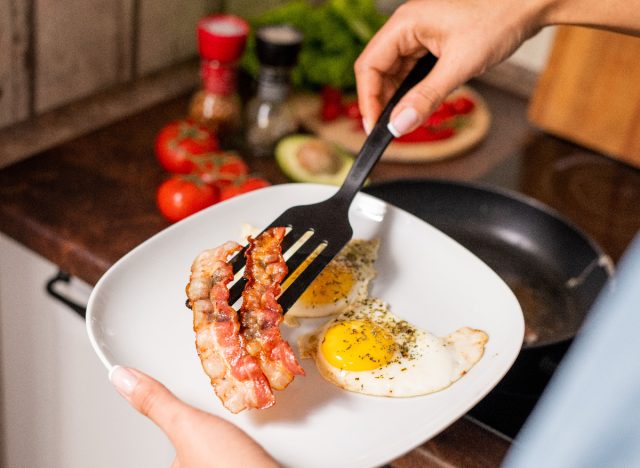10 Worst Protein Foods for Weight Loss

There are so many ways to modify your nutrition for weight loss. You can reduce your total calorie intake, narrow the timeframe in which you eat during the day, cut out certain foods, or follow a low-carb diet. If cutting carbs is your method of choice, you will likely find yourself eating much more protein. This can be good for weight loss for a few reasons. First, protein is very satiating, which can keep you fuller throughout the day and less likely to overeat. Protein also has a higher thermic effect than carbs, which can lead to more calories burned. Lastly, carbohydrates help store water in your body, so when you swap carbs for protein, you will naturally lose some water weight. With all of these benefits protein offers, you may be surprised to learn about the worst protein foods for weight loss, which we’ll get into today.
A high-protein diet can aid in weight reduction and may be able to prevent obesity and related disease, but know that not all protein foods are created equally. Fat, added sugar, and sodium are often present in high-protein foods. While each of these ingredients can be enjoyed in moderation, a diet high in any of these may slow weight loss. Added sugar and fat grams add calories to food, potentially creating an imbalance of calories consumed versus calories burned, and sodium may lead to weight gain from water retention.
When choosing high-protein foods for weight loss, there are a few key factors to keep in mind:
- Leaner is usually better—especially when it comes to animal protein.
- Limit your intake of fatty pieces of meat, and instead choose options like fish, poultry, and low-fat dairy.
- Choose minimally processed foods to reduce your intake of added sugar and sodium.
To help ensure you are making the most of your high-protein diet, there are some foods you should avoid. Here are the 10 worst protein foods for weight loss.

Although delicious and a good source of protein, fried chicken is notorious for being high in fat and sodium. While a single skinless chicken breast contains fewer than eight grams of fat, a fried chicken breast with skin could have upwards of 20 grams. This leads to a significant difference in calories and could make weight loss more challenging. Dark meat, which is also a good source of protein, is higher in fat than white meat and is often used in frying. This further contributes to calorie intake and could be slowing your weight loss progress.
Instead of fried chicken, choose grilled, baked, or air-fried options to limit additional fat, and enjoy white meat more often than dark.

A popular source of protein, sausage can be found on plates morning, noon, and night. Whether you are enjoying sausage with your eggs at breakfast, from a BBQ restaurant for lunch, or grilled and served in a bun for dinner, sausage is another protein that may be hindering your weight loss. Pork sausage, in particular, actually contains more fat than protein per ounce, and some varieties may provide more than one-third of your daily need of sodium in a three-ounce portion.
The spices, herbs, and seasonings in sausage are what make its unique flavor. For a similar flavor-packed protein with much less fat, try chicken or turkey sausage.

Salami is considered to be processed meat, which is the category of meats that have been cured, salted, or smoked to extend shelf life. This processing also tends to improve taste and texture, making cured meats a popular source of protein.
Unlike other common processed meats like deli turkey, salami has a high fat content that makes it a calorie-dense option. Salami is appealing because it requires zero preparation and can be enjoyed in numerous ways. However, if you are trying to lose weight, you may want to swap salami for deli turkey, ham, chicken, or roast beef. These options are lower in fat and calories and provide the same convenience and versatility as salami.

Perhaps one of the most common breakfast proteins, bacon is another high-fat meat. While lean meat options contain far more protein than fat, bacon provides nearly the same amount of fat and protein per serving. This is better than the ratios seen in sausage, but not by much. Pork bacon is the most common variety and the option with the highest fat content.
For a similar taste and texture, try turkey bacon. While this swap will reduce calories and fat, and it may provide more protein per ounce, it’s still a high-sodium food. Because of this, it is best to go easy on all forms of bacon and choose less processed meats more often.

The next time you attend a backyard BBQ, chances are, hot dogs are on the menu. Enjoyed by children and adults alike, hot dogs can be found in beef, pork, and turkey varieties. Like some other processed meats, you’ll find pork and beef hot dogs typically contain more fat than protein. While this gives hot dogs the flavor so many love, it also makes them high-calorie foods that can make weight loss more challenging. In addition, hot dogs are typically served on white bread, another poor source of calories, further contributing to weight loss woes.
You may be better off with a burger at your next BBQ, and if hot dogs are the only protein available, skip the bun and stick to just one frankfurter.

With so many options on the market, not all meal replacement bars are created equally. However, you can typically count on these bars containing high amounts of protein and calories. The convenience of these bars is hard to beat, but when you realize some options have upwards of 400 calories in a single bar, you may be better off with a different meal option. Although a 400-calorie count is not unreasonable for a meal, you’ll often find that added sugar makes up a portion of these calories. This may make the bar delicious, but less satiating than an option with less added sugar and more fiber. If bars are a convenient meal for you, look for options with minimal added sugar and at least three grams of fiber.

Compared to traditional yogurt, Greek yogurt is known for its higher protein content. This makes it an easy and versatile source of protein; however, the popular flavored options you may have in your fridge likely contain added sugar that could slow your weight loss efforts.
Greek yogurt can be enjoyed on its own, added to a smoothie as a protein source, or enjoyed with a variety of toppings to make a parfait. To limit the added sugar in your yogurt, go with plain Greek yogurt, and add your own toppings. Fresh fruit and nuts are great ingredients that add valuable nutrients without any added sugar.

These days, you’ll find many traditional food items now have a protein-infused variety. This is true for flavored oatmeal, cookies, and even chips. While oatmeal provides important nutrients like fiber and iron, flavored options are also known for their sugar content. A single serving of protein oatmeal could contain 10 grams of protein and equal amounts of added sugar. While the overall calories of this single serving are appropriate for a meal, the amount of added sugar is not.
Instead, try making your own protein oatmeal at home by cooking plain oats, adding in a scoop of your own protein powder, and incorporating fresh fruit for natural sweetness.

Traditionally, cookies are not a notable source of protein, but now you can find options infused with this nutrient. In theory, this sounds great, as you can get essential protein packed into a beloved treat. In practice, you may be disappointed to learn these protein cookies could steer you off course when it comes to shedding weight. These options also pack in the fiber, which is a plus, but still leave much to be desired nutritionally. Next time, just enjoy a single (non-protein-packed) cookie on its own, and get your protein from leaner, lower-calorie sources.

A ready-to-drink protein shake that can be pulled from the fridge and enjoyed on the go can be so convenient. There are some high-protein options in this category that keep calories at bay, but you may be surprised to see the added sugar in some varieties. A shake with 30 grams of protein contributes plenty to a meal; however, when that protein comes along with 25 grams of added sugar, you are better off getting your protein elsewhere.
Shakes can make a great snack or meal addition, but check the nutrition facts before your next purchase. Look for options with fewer than five grams of added sugar and at least 15 grams of protein for a better balance of nutrients.





